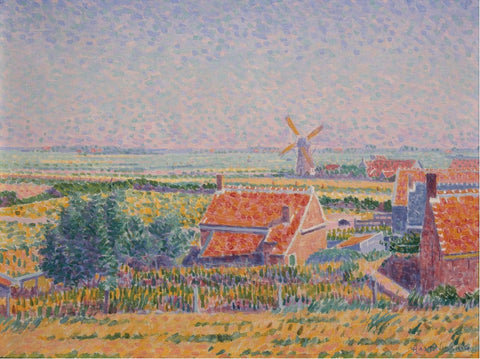Pointillism, 'invented' by George Seurat and Paul Signac, is the application of dots of paint in unmixed colors to the canvas. This technique really brings the light in the painting to life. The effect is especially visible if you stand some distance from the painting.

Pointillism, luminism, divisionism are all terms for a roughly comparable phenomenon in art: building the painted image from points, spots, dots and/or stripes of paint. Dots in complementary colors were often placed directly next to each other. The idea, based on then innovative insights into perception and the structure of light, was that our brains combine those colors and create a new color tone when you view the painting from some distance. You see the warm summer light captured in the work. Instead of dots, some pointillists put small, short strokes of paint on the canvas or a combination of dots and strokes.
In the Netherlands, Piet Mondriaan, Leo van Gestel, Hessel de Boer and, among others, Co Breman (1865-1938), Jan Toorop and Ferdinand Hart Nibbrig use the pointillist technique. Van Gogh also experimented with the technique, as shown in the work below.

Co Breman, who obtained a drawing teacher's certificate at the drawing school in his native city of Zwolle, went to Brussels in 1889 where he took lessons at the art academy for a few years. When he then goes to Paris to further his painting skills, he sees the work of Seurat and Signac. Breman is impressed by the warm and clear light that artists manage to get from their tubes. Co Breman settled in Het Gooi (first in Blaricum, then in Laren) where he joined the painters of the Larense School.

His paintings are bright and brightly colored in neo-impressionist style. The audience must first get used to the special, vibrating light. With dots in all kinds of pastel shades, it gives his paintings a sunny and intense appearance. Co Breman also uses the stippling technique in his landscapes, where his birthplace and the IJssel often form the meandering backdrop. He preferred to paint the dawn. Of course, Laren and the surrounding area is also a recurring theme.

Except for a two-year stay in Italy with his wife and artist Lizzy Schouten, Breman will live in the Gooi for the rest of his life. He plays an important role in the cultural life of Laren and Blaricum. He regularly exhibited his works at the exhibitions of 'De Tien', the Gooise painting club, of which he was secretary. He was a member of St. Luke in Amsterdam and Arti et Amicitiae. He has also had exhibitions abroad, including Madrid, Berlin, London, San Francisco and Glasgow. His works hang in museums in Haarlem, Madrid, Berlin and Dordrecht. In his memory, a 'Co Bremanlaan' has been named after him in Laren.
Ferdinand Hart Nibbrig (1866 - 1915) was also a pointilist painter and theosophist. In his first years as a painter, Hart Nibbrig mainly worked in the impressionist style of the Amsterdam School, but after a year in Paris (1890), he turned to pointillism under the influence of Vincent van Gogh and Georges Seurat. He was one of the artists who introduced luminism in the Netherlands, inspired by Camille & Lucien Pissaro. He did, however, abandon the strict color regulations of the French painters. He then painted with a refined point and then again with a looser technique of paint strokes, contour lines and. color smears. He lived in Laren, but also worked in Vlieland and Zoutelande in Zeeland, where Jan Toorop, together with Piet Mondriaan, also founded an artists' colony where Jan Sluijters, Maurice and Sarika Goth and Mies Elout wanted to capture Drabbe and the Zeeland light. It was therefore not surprising that Hart Nibbrigs' oeuvre from that time mainly consisted of landscapes, seascapes and portraits of the local population with an emphasis on the sea, the sun and light.

Hart Nibbrig often painted with a high point of view as you can see above. He could often be found outside, studying the light effects in the open air and portraying them in his works of art. He moved away from the brown and dark tones. This made him a founder of 'lighter' work for many other painters. The Hart Nibbriglaan in Laren is named after him.

Jan Toorop (1958-1928) had a major influence on Dutch art. Even more than Breman, van Gestel and Hart-Nibbrig. He applies many techniques from etching to watercolors and in all kinds of subjects. He was an avant-garde artist and perfected various techniques of Art Nouveau, Symbolism and Pointilism of Neo-Impressionism. He was one of the first followers of pointillism outside France. In the 1880s, dark, brown tones still predominated in the work of the Amsterdam Impressionists. It happened in Paris. Jan Toorop moved to Brussels in 1883 and became a member of the artist group Les XX, a group of progressive artists, which also included James Ensor, Félicien Rops and Fernand Khnopff. The group organized exhibitions that also showed the work of pointillists such as Paul Signac and Georges Seurat. Toorop had already admired their work together with Ensor in Paris in 1887. Toorop immediately adopted this new way of painting with colored dots. Toorop lived in Katwijk in the last years of the 19th century. The sea was an ideal environment for the pointillists. The strong reflections of water, light and air inspired them to optimally use their beloved stippling method.

